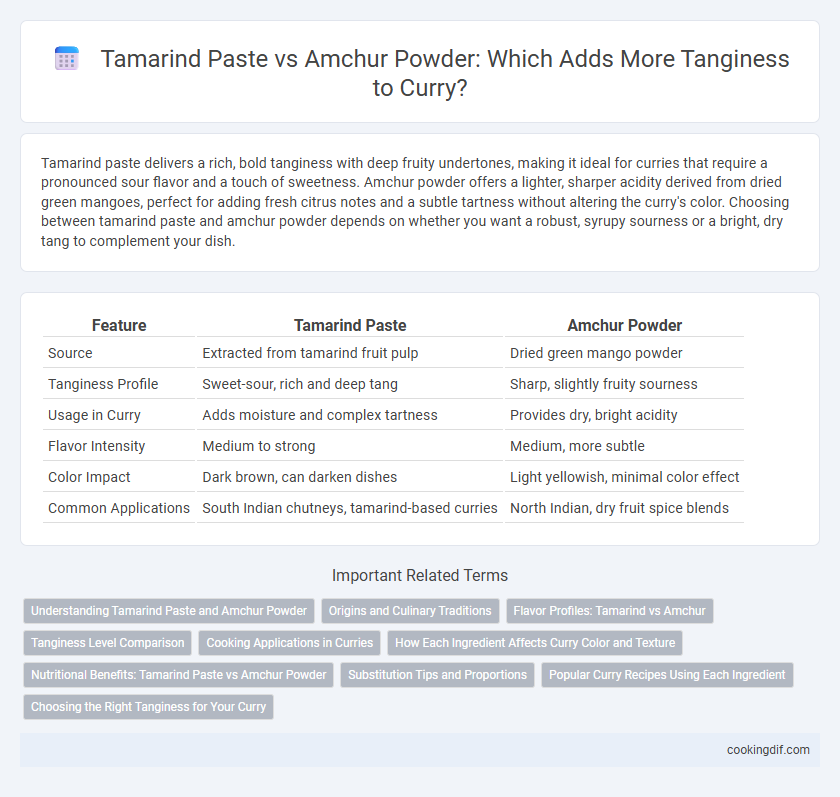Tamarind paste delivers a rich, bold tanginess with deep fruity undertones, making it ideal for curries that require a pronounced sour flavor and a touch of sweetness. Amchur powder offers a lighter, sharper acidity derived from dried green mangoes, perfect for adding fresh citrus notes and a subtle tartness without altering the curry's color. Choosing between tamarind paste and amchur powder depends on whether you want a robust, syrupy sourness or a bright, dry tang to complement your dish.
Table of Comparison
| Feature | Tamarind Paste | Amchur Powder |
|---|---|---|
| Source | Extracted from tamarind fruit pulp | Dried green mango powder |
| Tanginess Profile | Sweet-sour, rich and deep tang | Sharp, slightly fruity sourness |
| Usage in Curry | Adds moisture and complex tartness | Provides dry, bright acidity |
| Flavor Intensity | Medium to strong | Medium, more subtle |
| Color Impact | Dark brown, can darken dishes | Light yellowish, minimal color effect |
| Common Applications | South Indian chutneys, tamarind-based curries | North Indian, dry fruit spice blends |
Understanding Tamarind Paste and Amchur Powder
Tamarind paste, derived from tamarind fruit pods, offers a rich, deep tanginess with a slightly sweet undertone ideal for curries requiring intense, complex sour notes. Amchur powder, made from dried green mangoes, provides a lighter, sharper citrus flavor that brightens dishes without overpowering other spices. Understanding the distinct acidity levels and origins of tamarind paste and amchur powder helps cooks select the perfect tangy ingredient to balance and enhance curry flavors.
Origins and Culinary Traditions
Tamarind paste, derived from the pulp of the tamarind fruit native to tropical Africa and widely used in Indian, Thai, and Mexican cuisines, offers a rich, slightly sweet tanginess essential in curries and chutneys. Amchur powder, made from dried unripe mangoes indigenous to India, provides a sharp, fruity sourness that is a staple in North Indian dishes, enhancing flavors without adding moisture. Both ingredients reflect their cultural origins and culinary traditions, contributing distinctive tangy notes that define regional curry profiles.
Flavor Profiles: Tamarind vs Amchur
Tamarind paste delivers a rich, deep sourness with fruity and slightly sweet undertones, enhancing curries with a complex tangy flavor. Amchur powder offers a sharp, dry acidity derived from dried green mangoes, imparting a bright and crisp sour note that lifts dishes without added moisture. Both ingredients provide distinct tanginess, with tamarind adding a luscious texture and amchur contributing a vibrant, powdery zest.
Tanginess Level Comparison
Tamarind paste delivers a rich, deep tanginess with a sweet and slightly sour flavor, making it ideal for curries requiring complex sour notes. Amchur powder, derived from dried green mangoes, offers a sharper, more astringent tanginess that brightens dishes without adding moisture. The choice between tamarind paste and amchur powder depends on desired acidity intensity and texture in the curry.
Cooking Applications in Curries
Tamarind paste delivers a deep, rich tanginess ideal for slow-cooked curries, enhancing complex flavors with its fruity and slightly sweet notes. Amchur powder, made from dried green mangoes, offers a bright, sharp acidity perfect for quick tempering or finishing dishes where a fresh, citrusy tang is desired. Both ingredients amplify the tartness in curry recipes, but tamarind paste melds well in saucier, hearty curries, whereas amchur powder shines in lighter, dry curry preparations.
How Each Ingredient Affects Curry Color and Texture
Tamarind paste imparts a deep reddish-brown hue to curry and contributes a smooth, slightly thick texture, enhancing both richness and tanginess. Amchur powder, derived from dried green mangoes, adds a subtle yellowish tint and a fine, powdery texture that lightly brightens the flavor without altering the curry's consistency. The choice between tamarind paste and amchur powder influences not only the sourness but also the visual appeal and mouthfeel of the dish.
Nutritional Benefits: Tamarind Paste vs Amchur Powder
Tamarind paste is rich in vitamins C, B vitamins, and minerals like magnesium and potassium, contributing to its antioxidant and digestive benefits. Amchur powder, derived from dried raw mangoes, provides high vitamin C content and dietary fiber, supporting immune health and digestion. Both ingredients enhance curry tanginess while offering unique nutritional profiles that promote overall well-being.
Substitution Tips and Proportions
Tamarind paste and amchur powder both add tanginess to curry but differ in texture and intensity; tamarind paste is more acidic and fruity, requiring less quantity, typically 1 teaspoon of paste substitutes 1 to 1.5 teaspoons of amchur powder. When substituting tamarind paste for amchur powder, dilute the paste with water to balance its concentrated flavor and start with a smaller amount to avoid overpowering the dish. Adjust seasoning in small increments, tasting frequently to maintain the desired sourness and enhance the curry's flavor profile.
Popular Curry Recipes Using Each Ingredient
Tamarind paste, rich in a sweet and sour flavor, is a key ingredient in popular South Indian and Thai curry recipes like sambar and massaman, providing a deep tanginess. Amchur powder, made from dried green mangoes, lends a fruity, citrusy acidity commonly used in North Indian dishes such as chole and aloo curry. Both ingredients impart unique sour notes, with tamarind paste delivering a smooth, slightly sweet sharpness and amchur powder offering a lighter, fresh tartness that enhances the complexity of various curry recipes.
Choosing the Right Tanginess for Your Curry
Tamarind paste delivers a rich, slightly sweet tanginess that deepens the curry's flavor profile, making it ideal for South Indian or Thai dishes that require a robust sour element. Amchur powder provides a bright, sharp citrus-like acidity derived from dried green mangoes, perfect for North Indian curries needing a lighter, fresher sour note. Selecting between tamarind paste and amchur powder depends on the curry's regional style and desired intensity of tanginess to achieve balanced, authentic taste.
Tamarind Paste vs Amchur Powder for tanginess Infographic

 cookingdif.com
cookingdif.com